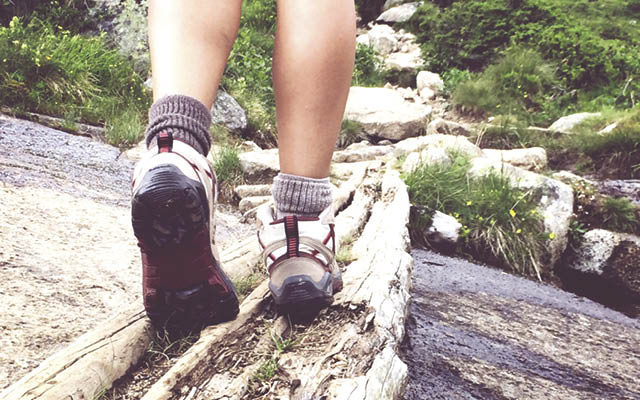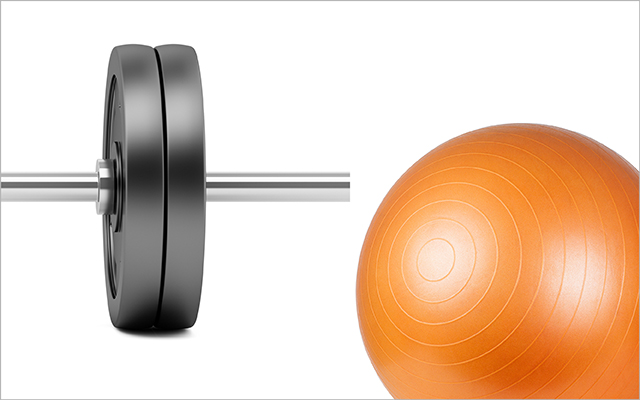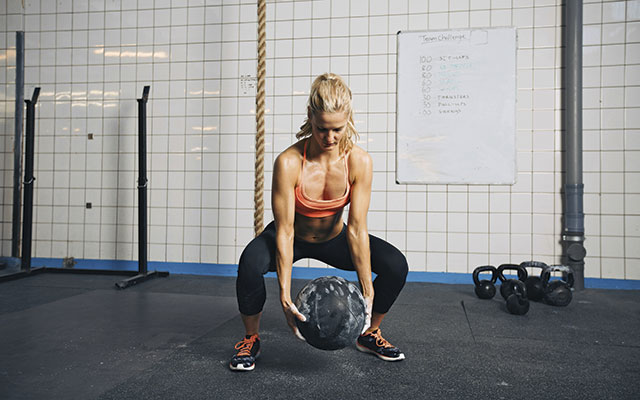Enter MovNat
What struck me immediately when I came across MovNat almost a year ago is the similarity between the movement patterns they emphasize and the movement patterns/motor skill milestones children naturally and automatically cycle through in the first few years of life if they are allowed the freedom to do so. These are the patterns which are simultaneously helping generate the neural connections that will allow children to do those academic-type things easily and fluidly — like read, write, work out math equations, solve complex problems, communicate, etc.
The following movements are from the list posted on the MovNat website and they mirror, in macro form, what infants and toddlers will naturally strive to do: moving on all fours, walking, running, balancing, climbing, jumping, lifting, carrying, throwing, catching (some might even add swimming, since infants introduced to it take to it easily).
Anyone who has had a child or spends time with small children will recognize these movements – they look different in an infant and toddler than they do in an 11-year-old or a 40-year-old — kind of like acorns are to saplings and then to oak trees — but, it’s all the same. And they are instinctual.
Long ago, the movements that naturally drive our development from the time we are infants would have been tied to our very survival, as well. We would have needed to access them on a daily basis, utilizing and refining our wide range of movement patterns and abilities throughout our life in a constantly challenging, sensorily-stimulating and often unpredictable natural environment.
It is no different today as far as our mind-body system is concerned – rich sensory environments, intelligent, complex movement, and a ‘fit’ mind go together. For life. Meaning — there is no natural movement expiration date. Play and movement outdoors and indoors is good for you — literally good for the whole picture of human health — for a lifetime.
Recent research actually shows that all of the sitting we do in these modern times is ‘killing’ us, shortening our life span. Studies on how sitting for long periods without movement breaks or access to recess and PE are learning killers and stress elevators for children are easily accessible with a quick Google search. It’s no different for adults. We’ve just adapted to it – poorly. Like the mother in my children’s class.
(For a short Humor Break that also introduces you to the science of movement and the brain, you might enjoy the clip “We Ignore How the Brain Works” by Dr. John Medina, neuromolecular biologist, brain researcher, and author.
But just in case you need more convincing that MovNat matters, I have some rat (and people) studies that might interest you ….
Your Brain on Movement: It’s All Good, But Sometimes It’s Even Better….
Dr. Marion Diamond conducted some seminal research out of Berkley in the 1980’s, demonstrating how different kinds of environmental input (enriched or impoverished) can alter the structure of the rat cerebral cortex and consequently, behavior.**
Her research shows that enriched environments can increase the dimensions of the cellular constituents of the cortex at ANY age from prenatal to extremely old age, (equivalent to 90-year-old people). Four days of enrichment can create statistically significant growth; just as four days of impoverishment can create statistically significant decreases in cortical development.
Dr. Diamond was pursuing her research before BDNF (brain-derived neurotrophic factor) was identified. If you are not familiar with BDNF, I offer you Dr. John Ratey’s short and sweet definition: “miracle gro for the brain.” Neurotrophins, such as BDNF, build and maintain neural circuitry, the infrastructure of the brain itself. In a nutshell, BDNF improves the function of neurons, encourages their growth, and strengthens and protects them against the natural process of cell death. And – key for us – it is released in excess when we elevate our heart rate (that’s code for ‘exercise’).
Once BDNF was discovered in the early 1990’s, an increasing number of researchers began investigating it. In 2007, a notable experiment showed that cognitive flexibility in human subjects improves after just one 35-minute treadmill session at either 60 or 70 percent of maximum heart rate. Cognitive flexibility is an important executive function. It reflects our ability to shift thinking and to produce a steady flow of creative thoughts and answers, as opposed to a regurgitation of rote responses.
In contrast, a control group of movie watchers showed no change in cognitive flexibility.
So, put rats and/or people in an impoverished environment (movie theater or rat cage without a wheel or other interactive object/obstacle) and we get no change in cognitive flexibility. Add running on a treadmill, wheel, or any simple aerobic activity and you get significant improvement.
This is great news, but what happens when we put our rats in an enriched environment? Enriched Environment (EE) is a code phrase for a situation where a wealth of stimulation in the form of physical activity, social interaction and challenging and intrinsic learning opportunities exist, such as might be encountered in the ‘rat race’ outside of the lab. These opportunities can be varied and controlled for different emphasis, but EE means more than just social opportunity or just aerobic opportunity.
Dr. William Greenough worked on multiple experiments with rats in various EEs starting in the 1980’s and ongoing. Repeated in various ways are experiments in which running rats are compared to others that were put in environments that encouraged them to engage complex motor skills, such as walking across balance beams, unstable objects, and elastic rope ladders. In one such study, after two weeks of training, the acrobatic/EE rats (vs. the rats who only had access to a wheel for running) had a 35% increase of BDNF in the cerebellum.
We are now in the realm of coordination of movement AND thought patterns. That’s even better. The wheel rats got increased benefit, which is wonderful, but it was the rats in the enriched environment, who experienced an increase focused in the cerebellum and hippocampus (memory and learning), Ratey, p 55.
In other words, hands (and paws) down, the enriched environment and complex movement wins when it comes to the most cognitive and physical benefits.***
Rich sensory environments, free exploration, and play come up ‘winning’ in another study – this one a longitudinal study on humans. One hundred and thirty three subjects were followed from infancy to adulthood. It was discovered that competency in adulthood stemmed from three major factors in the early learning environment: 1) rich sensory environments, both outdoors and indoors, 2) freedom to explore the environment with few restrictions, and 3) available parents that acted as consultants when the child asked questions.****
Imagine that.
“Learning is Experience. Everything Else is Just Information.” Albert Einstein
What begins to stand out more and more in the work we do and in the research we pore over are two key facts:
1. We are not fixed creatures – from birth to death we are capable of changing, of adapting. Neuronal growth is a constant gift – we have only to provide beneficial, rich sensory environments in which we can move, explore, and interact freely.
The most beneficial environment may just be right outside of our door and in our personal and extended communities: the classroom of nature and relationships. This lifelong classroom is free; its simplicity hides amazing complexity – an infinite playground of learning and growing for the human body, mind, and spirit. Add what you will to your life’s classroom, if it proves beneficial. We humans will ever be making tools – from the first rock used to smash a coconut open, to the spear, hammer, wagon, the car, the computer, etc. We keep making new tools and artifacts. Some improve our life and add significant value, others may serve in different ways that may not be as positive. In the end, you have to make wise choices for yourself and your family, because tools (technology) are not going away.
2. Our neuronal connections are always strongest and most active during sensorial learning experiences. And once a motor skill was mastered in these studies on learning and neural activity, much of the neural activity decreased.
This is why natural environments, constantly changing and presenting new challenges, movement and sensory, continue to be some of the very best for our brain. The more senses engaged – the more connections, and the more learning. Even fantastic playgrounds get mastered, but forests, rivers and mountains, oceans, coastlines, plains – all natural landscapes – are subject to the change of seasons, shifts of weather, the tread, wriggle & hop of beasts, insects, birds, worms, the sprouting of new flora, etc., displacing, rearranging. Constantly transforming, they invite us to do the same – to explore and engage wholeheartedly – to play – as children do. And so we continue to learn and grow. There is always something different – a new path to travel, a new obstacle to overcome, a new problem to solve, a new horizon to unlock – not only with our body and mind, but with our spirit, as well.
The Perfect Combo
On the final afternoon of the workshop, we switched to an indoor environment. Clifton divided us into two groups and instructed us to create a combo that could be practiced indoors using five of the basic MovNat movements. I still don’t know if he divided us up the way he did on purpose or if it was just coincidental, because the results were telling.
Jen is a former rugby star, super strong and dedicated to fitness. On her team were two personal trainers and a Crossfitter. On our team, were me (a yoga teacher/kids movement specialist), my business partner, Wendy, who works in the same fields, and a Crossfitter.
Jen’s team hit their five movements quickly. They were strong and solid: lifting, carrying, jumping, climbing, and crawling.
Our team (remember the Crossfitter was outnumbered, 2-1) focused on balancing, precision movements, jumping, crawling, tumbling and then finished it off with a med ball slam (thanks to our Crossfitter).
When we stepped back to look at what we had created and to comment, the preferences of each team were clear. Jen’s group created a tight, sharp strength-focused course. Our team (overwhelmed by yoga types used to playing with kids), created a balletic, flowing course that went over the movement limit (because we were having so much fun) and focused on slower and precise movement, with Adam’s med ball slam ending it all with a bang.
As Jen tweeted to me later, “Together, we would have designed the perfect combo.”
Balance and destabilization, randomness, integration and disintegration, sensory diversity. Stepping through Team Jen’s combo reminded me of how I felt discovering a new patch of woods to explore when I was a child. The unfamiliarity was exciting – my body and my mind were working as a unit and I had to use muscles in a combination/sequence I was both unfamiliar with and that called on more strength than I normally engage.
My team’s combo made Jen and her colleagues slow down, be more aware of their environment and use more control in varied ‘terrains’, which was also a less familiar and predictable training experience for them, and so challenged them in new ways.
Whatever the differences between our styles, our preferences, what we thought we should be good at, and what we thought would make us the strongest, the best, etc. … it all became unimportant as we moved through each other’s sequences. The learning experience was so sensorily full – the body, mind, and personality all engaged in the challenge of the experience, in the particularly absorbing joy of learning and mastering. Everything else falls away.
I’m all for immersing oneself in any kind of fitness or movement modality that calls to you: Kettle Bells, Crossfit, Yoga, Pilates, Martial Arts, Dance, Tai Chi, etc…there are so many. We tend to fix on what calls us, though. And as much as we believe we are open to experiencing other things, there is a tendency to be tugged along a narrow path by our personal inclinations – for strength or marathoning or Martial Arts or Eastern practices, etc.
The foundational movements are a seed planted in us, though, for a reason – optimal development reasons, optimal lifelong physical and cognitive health reasons. Nature is the cradle we have tested these movements in over millions of years of evolution, and they sustained us, meeting Nature’s sometimes playful, sometimes indifferent, and often challenging randomness with amazing adaptability, physical and cognitive; with curiosity, wonder, and creativity. Over and over again.
Do what the spirit moves you to do, by all means, but I would also offer this: consider our natural movement foundations, how they tie in with the health of our whole human system, and how it all fits into this lifelong health and happiness puzzle we are still piecing together. And if you’re intrigued, take a closer look at MovNat, find a workshop or make one happen. Experience, as you know, trumps intellectualizing any day of the week.
Note:
A special thanks to my business/creative partner, Wendy Piret. She quotes John Ratey by heart, has an uncanny ability to hold large amounts of fascinating research data in her head, and she often says what I mean to say before I say it. Her help with this post was invaluable.
**Basic Info on Dr. Diamond (http://ib.berkeley.edu/people/faculty/profile/more/mdiamond.php
***(For more information on Dr. Greenough and the results and potential significance of EE studies, visit http://www.dana.org/media/detail.aspx?id=7142). Wikipedia also has a very basic summary of EE research and its implication for primates & humans. http://en.wikipedia.org/wiki/Environmental_enrichment_(neural
****Thomas, Alexander & Stella Chess. Genesis and Evolution of Behavioral Disorders: From Infancy to Early Adult Life. American Journal of Psychiatry, 141(1), pp. 1-9. http://psycnet.apa.org/psycinfo/1986-30307-001





This Post Has 0 Comments